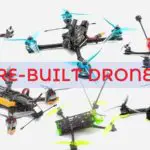You might wonder if you should be flying FPV drone in the winter or snow. After all, winter can last for a few months. It is boring if you can’t fly. On the other hand, you don’t want your drone to be damaged by the cold temperature. Here’s what you need to do if you want to fly an FPV drone in the winter.
To fly an FPV drone in the the winter, use a fully charged LiPo with a higher C rating. Warm up your LiPo before flying. Use anti fog coating to prevent fog on your goggles and waterproof your drone to prevent damage from contacting snows. Fly in a place protected from strong wind. Keep yourself warm and wear RC gloves to prevent frostbite.
It is tempting to fly in the winter, especially when it snows as that’s a whole new experience. Let’s drill in further to understand how to fly your done in the winter.
Can I Fly My FPV Drone in the Snow or Winter?

You can fly your drone in the winter, or when it snows. However, you need to understand the consequences and should take the necessary precautions when doing so.
Here are some difficulties that you might face when flying your drone under in the winter, and how to mitigate them.
Battery Failure
Under normal weather or in a controlled environment, your drone’s battery is already pushed to its limit when racing. But when it comes to flying under cold weather conditions, the chances are very high that the battery won’t be in its tip-top shape.
Cold temperatures decrease the chemical activity in LiPo batteries. As a result, the discharge rate of LiPo batteries drops with the temperature. The drop of battery performance becomes more apparent when it is below 50° F (10° C).
The direct impact on deteriorating discharge rate include shorter runtime, reduced top speed and overall power. As the batteries die faster, your drone is susceptible to mid-flight crashes.
Since a lower temperature can decrease the performance of your LiPo, it is intuitive to keep your LiPo warm. You can warm your LiPo battery to 77-95° F (25-35° C) using a LiPo warm bag before you fly. Don’t make it too hot as that will also damage your battery. As you fly, the current will generate enough heat to keep the LiPo warm.
Remember not to charge your LiPo battery when it is too cold as that will also damage your battery.
You can also consider using a LiPo battery pack with a higher C rating. That could help to maintain the required current draw rate. On top of that, it can also improve voltage sag issue that becomes more prominent at a lower temperature.
Using a fully charged LiPo pack will maximize your flight time. This can make a big difference in winter where battery performance is compromised.
Flying in a more gentle manner can also help to increase flight time at cold temperatures.
Visibility Problems

Expect limited visibility when flying under snow, especially if you are flying an FPV drone.
The snow, small debris, and other elements can easily stick on your drone camera and limits or completely remove your visibility. Once your vision is compromised, it’ll be hard to safely fly your drone.
Due to the temperature differences between your face and environment, your FPV goggle display tends to fog. You can reduce the fog by having a built-in fan or a compatible faceplate with a fan. Alternatives are anti fog sprays typically used on swimming goggles. According to some pilots, applying dish soap on the goggle display can also help to reduce fog.
Beware of Strong Winds
In the winter, weather elements can get more unpredictable. It only takes a strong gust of wind for your drone to be swept away. Make sure you keep an eye out on your flight patterns to help your drone avoid these complications.
Winds are your enemy. Not only does it make it harder to control your drone, strong winds also drain your battery faster. This is because your drone will need to spend more power to fly against the turbulence. As a result, your drone may stop flying sooner than it normally does.
Try to fly lower, or at places shielded from winds at 1 or more directions. A good example is the back alley. If you feel that you might lose control, land your drone asap.
Potential Damage of the Drone due to Moisture
Just like any electronic devices, your drone is susceptible to moisture. Once the electronic component of your drone gets contact with snow, the moisture can cause a short circuit.
You might see your drone suddenly stop flying and crash mid-flight. There are also chances where you are able to complete your flight safely, but the snow gets its way to the electronic component and melt as you get home. Once you power on your drone while the electronic component is still wet, that’s it for your drone!
You can reduce the chances of damage due to moisture by waterproofing your drone. Get some silicone conformal coating and apply it to your electronic component except buttons, sockets and plugs. Refer to the How to Waterproof Your Drone section of this guide for more details about waterproofing your drone.
If your drone unfortunately crashes into snow and it is snowing, you should try to locate it immediately. Otherwise it might be completely covered by snow. If your drone is waterproof, it should stay safe in the snow. Otherwise, the heat from the battery may accelerate condensation and cause a short circuit if the power supply is not cut off in time.
Once you locate your drone, turn it off immediately even if your drone is waterproof to prevent further damage to your drone. Moreover, who knows if the waterproofing feature remains intact after the crash.
Then, let it air dry for a couple of days. If you want to help get the process along, you can use a hair dryer to blow-dry your drone. However, make sure that the air isn’t too hot.
Never plug in the battery until everything including the battery port is completely dry. Don’t try to do a test flight unless you’re completely sure that all the parts are completely dried off.

Protect Yourself
We have covered a lot on your drone. Let’s not forget about yourself!
Other than the normal clothing that you would wear in winter, consider getting a radio transmitter gloves (Amazon | Banggood). It protects your fingers from frostbite without hindering you from operating your radio transmitter.
You can also put some heat pad or hand warmer into the gloves to provide you with extra warmth.
Final Thoughts
Flying your drone in winter requires extra precautions and preparations. It is important to make it safe to you and your drone.
If it is too much a hassle to fly in winter, why don’t you try a simulator? There are a few realistic and affordable drone simulators out there that can keep you busy in the long winter.


